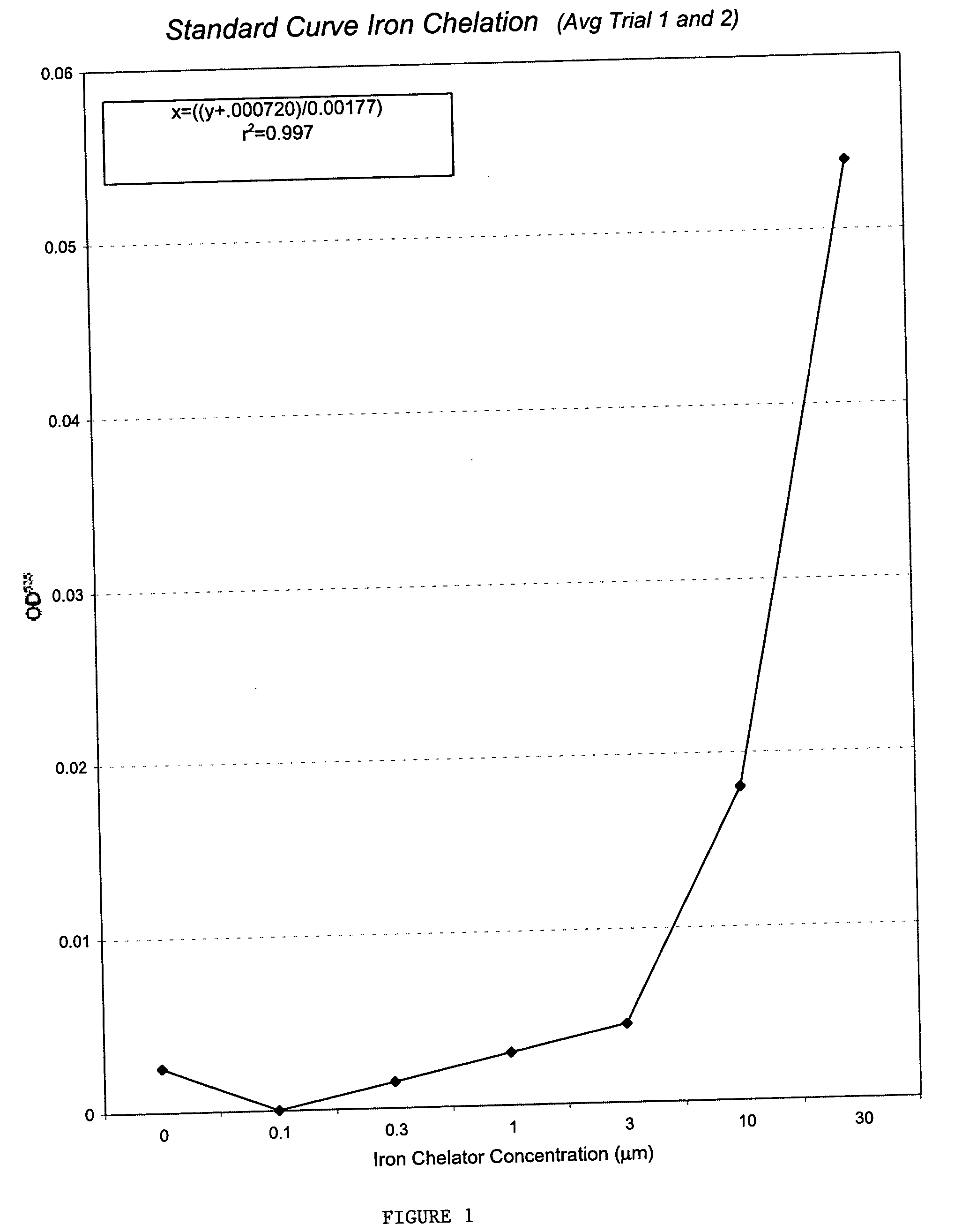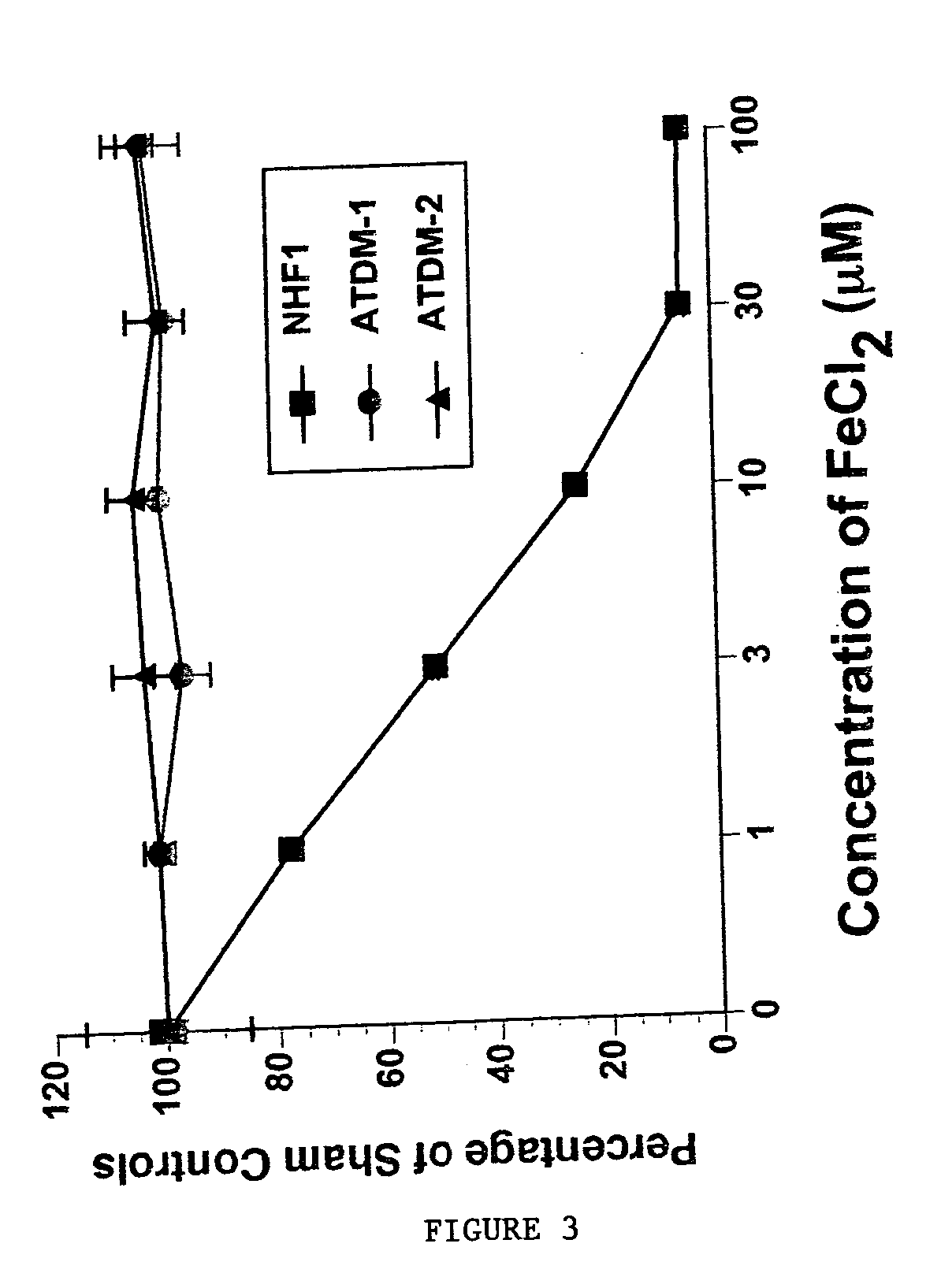Methods and compositions for treatment of ataxia-telangeictasia
a technology of ataxia and telangeictasia, applied in the field of ataxia-telangeictasia treatment methods and compositions, can solve the problems of increasing the risk of breast cancer in heterozygotes, exacerbate genomic instability, and limited treatment options for patients, so as to reduce oxidative stress and increase genomic stability
- Summary
- Abstract
- Description
- Claims
- Application Information
AI Technical Summary
Benefits of technology
Problems solved by technology
Method used
Image
Examples
example 1
Preparation of Cells
[0087] AT22, an SV40-transformed skin fibroblast cell line, was obtained from David Cortez at the Baylor Medical School. VA13, an SV40-transformed normal fetal lung fibroblast cell line, was obtained from ATCC (Rockville, Md., USA). pEBS7 and pEBS7-YZ5 tumor cell lines were a generous gift from Dr. Yosif Shiloh at the Sacker School of Medicine, Tel Aviv University, Israel (See Y. Ziv et al. 15 Recombinant ATM Protein Complements the Cellular A-T Phenotype, ONCOGENE 159-167 (1997).). The NHF1 normal foreskin human fibroblast primary cell strain was a generous gift from Richard Pales at the National Institute of Environmental Health Sciences. The primary dermal AT fibroblast cells strains ATDM-1 and ATDM-2 were obtained by skin biopsy from two males, ages 10 and 14, diagnosed with AT and previously demonstrated to lack pATM expression, see FIG. 15, Example 3. The AT22 and VA13 cells lines were cultured in DEEM containing 5% FRS and 1% penicillin / streptomycin / gluta...
example 2
Mitotic Delay Assays
[0090] Mitotic delay assays were performed as previously described (See R. E. Shackelford et al. The Ataxia telangiectasia Gene Product Is Required for Oxidative Stress-induced G1 and G2 Checkpoint Function in Human Fibroblasts, 276 J. BIOL. CHEM. 21951-21959 (2001)). In brief, cells were plated onto 100 mm tissue culture plates and incubated 48-72 h (to approximately 50% confluency). The cells were then treated with FeCl2 for 15 m as in the colony forming-efficiency assay, washed 2× with media, cultured 2 h, and the media was removed. The cells were fixed in 5 ml cold methanol for 10 min and air-dried. The cells were stained with 0.2 μg / ml 4′,6-diamidino-2-phenylindole (DAPI) in water and examined by fluorescence microscopy. The percentage of mitotic cells (mitotic delay) was determined by counts of 5,000 cells. Mitotic delay experiments were performed in triplicate and the standard deviations were calculated as in the colony forming-efficiency assays. (FIG. 3)...
example 3
Western Blot Analysis
[0091] Cells on 100 mm tissue culture plates were washed 3× with phosphate buffered saline, harvested by scraping, and pelleted at 1000 g for 5 min. The resulting cell pellets were resuspended in 250 μl 1× lysis buffer (1% NP-40, 10 mM Sodium Phosphate [dibasic], 1 mM EDTA, 5 mM glycerol phosphate, 1 mM DTT, 150 mM NaCl), with protease inhibitors (Aprotonin 4.0 g / ml, Leupeptin 0.75 μ / ml, Phenylmathanesulfonyl Fluoride 340 μg / ml) and placed into a microcentrifuge tube. The suspension was centrifuged at 4C for 20 min at 13000 g and the supernatant, total cellular protein, was put into a microfuge tube for protein quantification. Primary antibody N514 (kindly provided by Dr. R. Paules at the National Institute of Environmental Health Sciences) was added to each protein sample and tumbled 2 h at 4C. 20 μl protein G-Sepharose beads were added (GIBCO BRL) and the tubes were tumbled for 30 min. The G-Sepharose beads were washed 3× with in 1 ml lysis buffer with quick ...
PUM
| Property | Measurement | Unit |
|---|---|---|
| Pharmaceutically acceptable | aaaaa | aaaaa |
| Stability | aaaaa | aaaaa |
| Stress optical coefficient | aaaaa | aaaaa |
Abstract
Description
Claims
Application Information
 Login to View More
Login to View More - R&D
- Intellectual Property
- Life Sciences
- Materials
- Tech Scout
- Unparalleled Data Quality
- Higher Quality Content
- 60% Fewer Hallucinations
Browse by: Latest US Patents, China's latest patents, Technical Efficacy Thesaurus, Application Domain, Technology Topic, Popular Technical Reports.
© 2025 PatSnap. All rights reserved.Legal|Privacy policy|Modern Slavery Act Transparency Statement|Sitemap|About US| Contact US: help@patsnap.com



